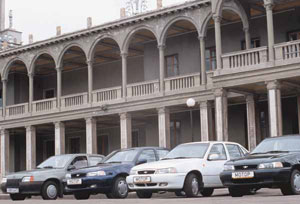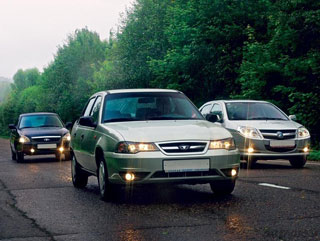Daewoo Nexia (Kletn) 1995 test drive - NV sedan
"Nexia" and "Clio" - an occasion for thoughts
What are guided by when buying an inexpensive new foreign car? It is unlikely that the buyer is looking for outstanding external data, prestigious interior or extraordinary sled qualities. All this appears at a completely different price level. And here, where the main competitor is domestic technology, which does not indulge in the consumer by either service or comfort, I want just something moreatical and more divided. And let friends and acquaintances scare the disadvantage of corporate service, high cost repairs, especially the body, inappropriate of delicate cars to climate and roads. Nevertheless, a person wants to abandon the constant worries about his iron friend for a while.
It is unlikely that the buyer is looking for outstanding external data, prestigious interior or extraordinary sled qualities. All this appears at a completely different price level. And here, where the main competitor is domestic technology, which does not indulge in the consumer by either service or comfort, I want just something moreatical and more divided. And let friends and acquaintances scare the disadvantage of corporate service, high cost repairs, especially the body, inappropriate of delicate cars to climate and roads. Nevertheless, a person wants to abandon the constant worries about his iron friend for a while. A couple of Dau Nexia and Renault Clio Symbol (see ZR, 2000, No. 6) was selected by us for similar ideological reasons. Moreover, we deliberately cut the budget in order to bring the cost of cars to the price of Russian products. Both cars are very vigorously wraps kilometers by the odometers are selected to the mark of a large (20,000 km) then.
 Their drivers were almost weaving regularly to climb under the hoods, look for places of sudden anti-oil leaks, and discuss with colleagues the secrets of cunning malfunctions. In order to at least somehow compensate for the itching in their hands, they got all kinds of auto-cosmetics, in order to, with its help, express care of their iron friend.
Their drivers were almost weaving regularly to climb under the hoods, look for places of sudden anti-oil leaks, and discuss with colleagues the secrets of cunning malfunctions. In order to at least somehow compensate for the itching in their hands, they got all kinds of auto-cosmetics, in order to, with its help, express care of their iron friend. Another interesting feature was manifested. Any, the most insignificant failure in a slender system, the driver immediately causes irritation. It doesn’t matter whether it is a pierced wheel or a screaming door upholstery, a desire immediately appears to criticize all this immediately, and fixing it, forget it like a bad dream. So, the most serious breakdown to Clio, the refusal of the turning relay immediately caused a feeling, if you like, joyful indignation: it began! However, as it turned out at the maintenance station, the defect is characteristic of the entire batch of cars sold with ours, so that the sensation did not work: the relay was changed under the warranty, so to speak, in a planned manner. A colleague traveling to Nexia is still complaining of excessive oil appetite: she eats around a liter of engine oil for interservice 10,000 km. Crime, in general, no, but you yourself understand
 And yet something had to be adapted, for our wards are not in many ways ideal. So, on Renault Clio, I could not get used to the low doorway and an uncomfortable landing for a long time. As if this car was made for long -armed and short -legged, and the rest left only compromise options. Even now, after a few months, when I already learned to bow, climbing into the car, and incorrectly sitting at the wheel, the inconvenience periodically crawl out. For example, a small journey through the Vologda expanses showed that an unnaturally curved right leg after 200300 km is so tired that you have to stop and give her rest.
And yet something had to be adapted, for our wards are not in many ways ideal. So, on Renault Clio, I could not get used to the low doorway and an uncomfortable landing for a long time. As if this car was made for long -armed and short -legged, and the rest left only compromise options. Even now, after a few months, when I already learned to bow, climbing into the car, and incorrectly sitting at the wheel, the inconvenience periodically crawl out. For example, a small journey through the Vologda expanses showed that an unnaturally curved right leg after 200300 km is so tired that you have to stop and give her rest.  Back in the run -in period, Renault fenced the unexpectedly high fuel consumption. Not an example of the Vazovskaya eleventh, in the city hustle and bustle consuming 8.28.5 l/100 km, the Frenchman was more gluttonously per liter-half. Perplexity only intensified when on the highway the symbol easily met 6.57 l/100 km. I had to turn to the reference books. It turned out that the manufacturer honestly promised very similar numbers, therefore, we ride 10 in the city, and outside it is 6.
Back in the run -in period, Renault fenced the unexpectedly high fuel consumption. Not an example of the Vazovskaya eleventh, in the city hustle and bustle consuming 8.28.5 l/100 km, the Frenchman was more gluttonously per liter-half. Perplexity only intensified when on the highway the symbol easily met 6.57 l/100 km. I had to turn to the reference books. It turned out that the manufacturer honestly promised very similar numbers, therefore, we ride 10 in the city, and outside it is 6. It should be noted that the process of driving on the symbol, in general, is not monitoring. Comfortable suspensions, a power steering, a painful motor, a good acoustic comfort make this car very convenient, especially in the city. Here, Clio is like a fish in water: it sensitively performs all the driver’s commands, without requiring frequent gear. You need to adapt only to too nervous the brake pedal that requires
 just tender touches. However, in the speed stream of suburban tracks, our fish is no longer so perfect. Suspensions do not cope with gentle waves on the asphalt the body is prone to vertical buildup, especially loaded. The steering wheel at high speed is not informative enough, and the car begins to swim on the road. The engine is a noisy at high speeds of the urban set of gear rates. In general, you can ride outside the city, but runs over long distances are tiring.
just tender touches. However, in the speed stream of suburban tracks, our fish is no longer so perfect. Suspensions do not cope with gentle waves on the asphalt the body is prone to vertical buildup, especially loaded. The steering wheel at high speed is not informative enough, and the car begins to swim on the road. The engine is a noisy at high speeds of the urban set of gear rates. In general, you can ride outside the city, but runs over long distances are tiring. Dau Nexia, on the contrary, is better adapted to long trips. The stretched row of gear ratios in the box, more rigid, not inclined to swing the suspension body, other landing of the driver and much more stable behavior at high speed allow, without unbending, to sit at the wheel much more time. Here, there are much more freer, there is some reserve of space in height and sides, which, in general, is preferable in long-distance travel than the tightness of the urban small-leaf. However, the venerable age of the model is felt not only in appearance. A sluggish brake pedal, an uncomfortable clutch, a fuzzy gear shift mechanism, some kind of strangled, as if the engine begging the engine is not only deprived of a hint of side support, but simply breathing in a frailly one, at every attempt to sit comfortably.
 In terms of operational fuel costs, Nexia is close to Renault: in the city it eats about 9 l/100 km. But in operational expanses the situation is changing. Interesting, but in a joint almost two -thousand -high mileage, both cars demonstrated enviable similarity. No matter how much we discuss the city essence of one and the track another, the same amount of gasoline included the same gas station in the tanks of cars. Also almost equally, despite the difference in the size and concepts, and Dau Nexia and Renault Clio, without any problems, survived the July heat and a whole set of roads: from a good asphalt to the peas of cobblestone and even grader, which was laid down under the king. Of course, they spilled a little, the Moshkars were added, but they returned without losses.
In terms of operational fuel costs, Nexia is close to Renault: in the city it eats about 9 l/100 km. But in operational expanses the situation is changing. Interesting, but in a joint almost two -thousand -high mileage, both cars demonstrated enviable similarity. No matter how much we discuss the city essence of one and the track another, the same amount of gasoline included the same gas station in the tanks of cars. Also almost equally, despite the difference in the size and concepts, and Dau Nexia and Renault Clio, without any problems, survived the July heat and a whole set of roads: from a good asphalt to the peas of cobblestone and even grader, which was laid down under the king. Of course, they spilled a little, the Moshkars were added, but they returned without losses. Probably, many again have a reasonable question: so what is the real advantage of an inexpensive foreign car? Indeed, by and large, neither one nor the other car is deprived of flaws. Moreover, if you compare them with the same dozen, especially sixteen -valve, I venture to assume that the latter will be not only frozen and more economical, but also much more convenient.
Let us, however, abandoned the ceremonial numbers in characteristics and look at the domestic car differently. Outside, the cracks and a non -binding of details, in the cabin, dull fabrics and poorly fitted plastic. And if you dig a little deeper? With difficulty, the working ventilation system, where forever jamming damn it interferes with normal air circulation, creaking and winding windshields, frantically twitting at high speed, suffering from chronic tires and wheels, living a restless life of starters, expansion tanks, this list can be continued endlessly. Agree, all this requires strength, nerves, and most importantly.
A foreign alternative so far allows you to exist with a minimum of physical and temporary costs. Let's see how long this is enough. z
The tightness of the doorway of Renault (left) is better, Nexia (on the right) spilled stronger.


Text / Sergey Voskresensky
Photo / Vladimir Knyazev
Source: The magazine "Driving"
Daewoo Nexia (Kletn) 1995 - NV Daewoo
Daewoo Nexia (Kletn) 1995 - NV
Daewoo Nexia malfunctions: Detailed information| Nexia (Kletn) 1995 - HB | |
|---|---|
| Engine |  |
| Transmission |  |
| Control system and suspension |  |
| Brake system |  |
| Air heating and air conditioning |  |
| Launch and charging system |  |
| Electric components and so on |  |
| Corrosion body stability |  |

_1995_-_nv_10.jpg)
_1995_-_nv_11.jpg)
_1995_-_nv_12.jpg)
_1995_-_nv_13.jpg)
_1995_-_nv_14.jpg)


